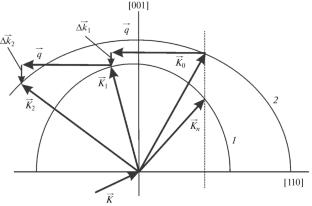双声子布拉格衍射过程中的光辐射相变
IF 0.48
Q4 Physics and Astronomy
Bulletin of the Russian Academy of Sciences: Physics
Pub Date : 2025-10-07
DOI:10.1134/S1062873825712486
引用次数: 0
摘要
本文从理论上和实验上研究了双声子声光衍射过程中零布拉格阶相位随声波频率变化的变化。结果表明,如果衍射发生在各向异性的陀螺晶体中,通过改变波的相位,可以实现线极化辐射的偏振面可控旋转。本文章由计算机程序翻译,如有差异,请以英文原文为准。

Optical Radiation Phase Change during Two-Phonon Bragg Diffraction
The change of the zero Bragg order phase during the two-phonon acousto-optic diffraction upon variation in the acoustic wave frequency has been theoretically and experimentally investigated. It is shown that, changing the phase of the wave, one can implement a controlled rotation of the plane of polarization of linearly polarized radiation if the diffraction occurs in an anisotropic gyrotropic crystal.
求助全文
通过发布文献求助,成功后即可免费获取论文全文。
去求助
来源期刊

Bulletin of the Russian Academy of Sciences: Physics
Physics and Astronomy-Physics and Astronomy (all)
CiteScore
0.90
自引率
0.00%
发文量
251
期刊介绍:
Bulletin of the Russian Academy of Sciences: Physics is an international peer reviewed journal published with the participation of the Russian Academy of Sciences. It presents full-text articles (regular, letters to the editor, reviews) with the most recent results in miscellaneous fields of physics and astronomy: nuclear physics, cosmic rays, condensed matter physics, plasma physics, optics and photonics, nanotechnologies, solar and astrophysics, physical applications in material sciences, life sciences, etc. Bulletin of the Russian Academy of Sciences: Physics focuses on the most relevant multidisciplinary topics in natural sciences, both fundamental and applied. Manuscripts can be submitted in Russian and English languages and are subject to peer review. Accepted articles are usually combined in thematic issues on certain topics according to the journal editorial policy. Authors featured in the journal represent renowned scientific laboratories and institutes from different countries, including large international collaborations. There are globally recognized researchers among the authors: Nobel laureates and recipients of other awards, and members of national academies of sciences and international scientific societies.
 求助内容:
求助内容: 应助结果提醒方式:
应助结果提醒方式:


